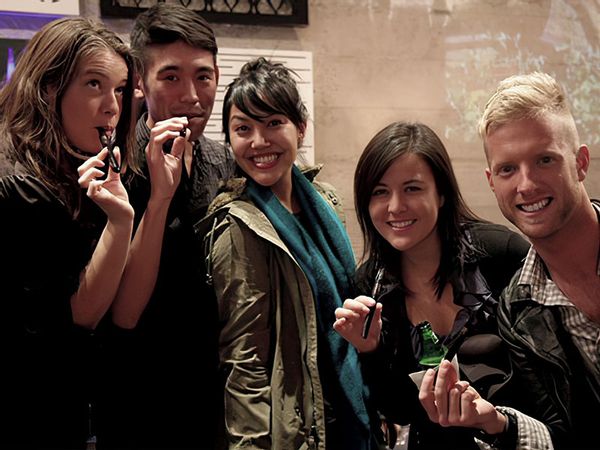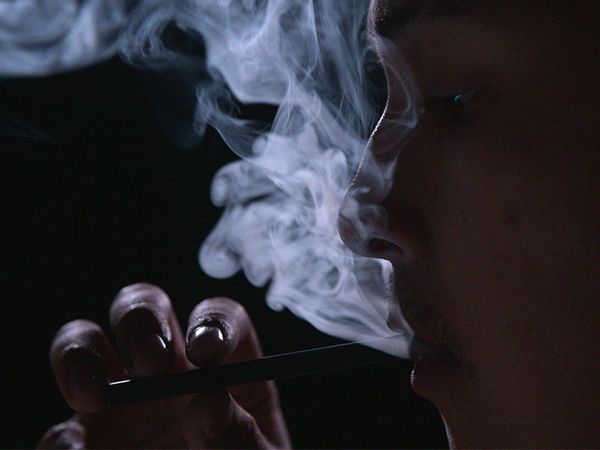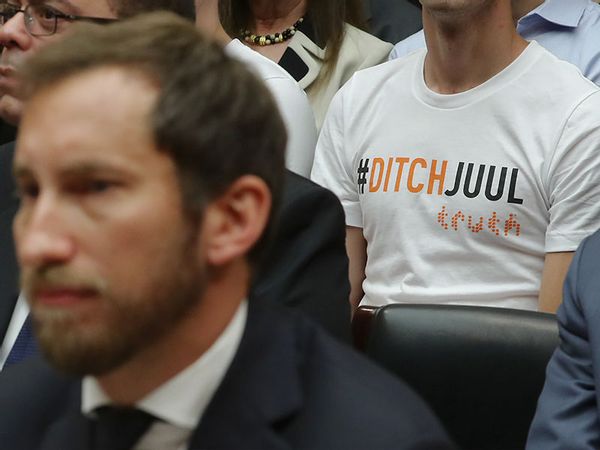When Juul was first conceived, it was set on being a new kind of electronic cigarette (or e-cigarette) that would help adult smokers finally quit a longstanding habit. Juul was meant to be a leading tech company. But years later, it became much more sinister than it could’ve imagined.
The e-cigarette company was founded by Adam Bowen and James Monsees, two ex-cigarette smokers who met while they were graduate students in product-design at Stanford University. Bowen and Monsees were determined to create a sleek e-cigarette that wasn’t anything like its goofy-looking predecessors. They first developed an e-cigarette called Ploom and later, developed Pax vaporizers for cannabis and loose-leaf tobacco. Juul was created in 2015 and quickly became one of the fastest-growing companies in the world.
Today, Juul is long past its glory days and instead, marred by infamy. The product, which was created for a good cause, ultimately became a public health crisis after it got in the hands of countless children and teens nationwide. Once disaster struck, the company struggled to redeem itself in the public eye.
Juul’s epic rise and subsequent downfall is explored in Netflix’s latest docuseries “Big Vape: The Rise and Fall of Juul.” Over the course of four episodes, the documentary explores Juul's early mission, its financial success and its ardent backlash through a series of interviews and old footage. Current and former employees of the company make several appearances throughout the feature. A few even chose to remain unnamed and anonymous for their own safety. As for Bowen and Monsees, they both agreed to not be featured in the documentary.
“At its height, Juul employed over 4,000 people, and was valued at nearly 40 billion dollars,” the documentary said in its opening. “Today, it’s worth less than 5% of that value.”
Here are the 6 biggest Juul revelations from the series:
 Big Vape: The Rise and Fall of Juul (Photo courtesy of Netflix)
Big Vape: The Rise and Fall of Juul (Photo courtesy of Netflix)In the summer of 2013, Bowen brought on a chemist named Chenyue Xing to figure out how to make the nicotine delivery of Juul equal to that of an actual cigarette. Many Juul users complained that they were still smoking cigarettes because of Juul's low and impotent nicotine levels.
Earlier generations of e-cigarettes used freebase nicotine, a form of the drug which can be incredibly difficult to inhale. Freebase nicotine was also difficult to raise in content because too much of it in an e-cigarette would produce an unpleasant, bitter taste. To combat that issue, Bowen and Xing decided to make salt nicotine — a combination of nicotine and a weak organic acid. Salt nicotine produced a “softer,” less harsh taste while still providing an adequate hit to its users.
When it came to product testing, Jamie Ducharme, the author of the “Big Vape” series, said Bowen and Xing recruited their own co-workers to test the Juul products.
“It was called ‘buzz testing,’ because it’s a commonly-used term by smokers to describe the nicotine head hit that they feel,” Xing, who declined to appear in front of the camera, said.
An unnamed, anonymous engineer for Ploom described the test as “simple”: testers were asked to take 10 puffs in two minutes and describe how they felt.
“Around the fourth or fifth puff, I would have to start tallying because I’d hit the buzz so hard I’d be like, ‘Where am I?’ Then I’d come back and be like, ‘I’m done with number six,’” they said.
“The potency, I had never really felt anything like that before since high school, when I tried my first cigarette. Like a punch in the face, ‘Whoa!’ It really opened our minds to what was possible.”
 James Monsees in "Big Vape: The Rise and Fall of Juul" (Photo courtesy of Netflix)
James Monsees in "Big Vape: The Rise and Fall of Juul" (Photo courtesy of Netflix)A supply chain engineer, who remained unnamed and anonymous in the documentary, said Juul pods were a major problem — out of 100 Juuls produced, only eight contained effective pods.
David Pierce, a reporter for Wired, said many users got “a squirt of nicotine” in their mouth when they would inhale a Juul with a faulty pod.
“One employee said he got crème brûlée liquid [a popular Juul pod flavor before it was banned] in his mouth so often that he now can’t eat [actual] crème brûlée because it was so disgusting,” said Ducharme.
Juul's sleek and slim design posed a technical challenge. It was difficult to fit in a battery, tubes and a small enough pod that was also functional.
“People would say, ‘We need a bigger unit,’” recalled Juul's supply chain engineer. “James [Monsees] refused to budge on the unit size. He really liked the way that unit looked.” Another Juul employee said they were rushed: “About a month before the original launch date, we didn’t have a way to fill pods yet.”
Monsees was adamant that the problems be fixed in that short amount of time. And if they weren’t, Juul would still be launched regardless.
“Ever heard the old adage, ‘When in doubt, ship it?” Monsees is heard saying in an old recording. “There’s a variation on that one, which is ‘F**k it, ship it.’”
 Big Vape: The Rise and Fall of Juul (Photo courtesy of Netflix)
Big Vape: The Rise and Fall of Juul (Photo courtesy of Netflix)Juul quickly became known as a tobacco-adjacent company thanks to its gaudy marketing. What once began as a business seeking to help adults quit smoking actually encouraged more users — namely adolescents — to pick up the habit.
Juul's marketing campaign recruited so-called “cool kids,” who were average yet incredibly good looking millennials, posing and dancing while taking puffs from their e-cigarettes. The resulting advertisements were sophisticated, flashy and alluring, which made the product seem like a sort of toy or lifestyle accessory rather than a beneficial health device. Many were quick to notice that Juul ads greatly resembled those of Big Tobacco companies.
“Juul, in its advertising, faithfully followed the playbook of Big Tobacco companies and their cigarette brands,” explained Dr. Robert Jackler, a tobacco marketing expert at Stanford. “[Juul's] Vaporized campaign. It has direct roots from the way the tobacco industry marketed to youth. Take a bunch of 20-somethings, and you have them dance around."
Jackler added that Juul took the “very worst” elements of tobacco marketing and thrived on that.
“Cigarette makers could no longer advertise on television. Juul could. Cigarette makers could no longer have a billboard on Times Square. Juul could,” said Dr. Robert Proctor, a tobacco historian at Stanford.
Shortly after Juul's Vaporized campaign came out, Ad Age magazine published an article that formally called out the company's advertisements for looking very similar to old Big Tobacco ads. Juul's marketing team, led by chief marketing officer Richard Mumby, went into hyperdrive and began redoing aspects of the campaign, even though it had just been released.
Many employees said Juul had become a hot mess at that point and pointed fingers at the company's creative leadership, who they claimed had "no knowledge of what was responsible marketing of a tobacco company."
 Big Vape: The Rise and Fall of Juul (Photo courtesy of Netflix)
Big Vape: The Rise and Fall of Juul (Photo courtesy of Netflix)Juul's inconspicuous design allowed many young people to discreetly use the product in schools. Many kids tucked their Juul inside their sweatshirt, occasionally taking puffs and exhaling into their sleeves without their teachers knowing. Users as young as 12 and 13 years old were also seen using and passing Juuls around in public, like they were candy.
Juul's social media team began doing damage control to sway away from the negative publicity and encourage more adults to use the product responsibly. The company’s social media posts abandoned the Vaporized campaign and instead, displayed images of older folks carrying Juuls. The company's social media team also limited the use of bright colors and ultimately, made its account “stodgy and boring.”
 Big Vape: The Rise and Fall of Juul (Photo courtesy of Netflix)
Big Vape: The Rise and Fall of Juul (Photo courtesy of Netflix)Two students recalled the time their school hosted a mental health seminar and invited a mental health speaker to come and talk to them about addiction and drug usage. The so-called “mental health speaker” turned out to be a representative for Juul, who advocated for the product rather than against the consequences of smoking or vaping.
“Throughout the presentation, there were slides up in which the speaker was discussing how the Juul was not harmful and how it was 99.9% safer than combustible cigarettes,” said Caleb Mintz. “That’s an actual statistic that was used in the presentation.”
“He also pulled a Juul out of his pocket and referred to it as the iPhone of vapes. So he really came off as a salesman.”
Phillip Fuhrman, a teen vaper who began vaping between eighth and ninth grade, said he was convinced that vapes weren’t harmful and didn’t feel compelled to quit after the presentation. Mintz, however, had different thoughts: “After the presentation, I didn’t find that many people shared the sentiment that I had, that this guy was trying to market nicotine products to a bunch of teenagers. It was so absurd, I didn’t feel like a lot of people would believe me, and I felt like the only person who would listen would be my mom.”
 Big Vape: The Rise and Fall of Juul (Photo courtesy of Netflix)
Big Vape: The Rise and Fall of Juul (Photo courtesy of Netflix)Per the documentary, the U.S.Food and Drug Administration (FDA) rejected Juul's premarket tobacco product applications (PMTAs) and ordered the company to pull all of its vaping products off the market. Juul, however, successfully appealed the ban and “remained on the market, pending another PMTA review.”
“At the end of 2023, Juul has paid nearly $3 billion in legal settlements across the United States,” the documentary continued. “The future of the company remains uncertain.”
"Big Vape: The Rise and Fall of Juul" is currently available for streaming on Netflix. Watch a trailer for it below, via YouTube:

Shares